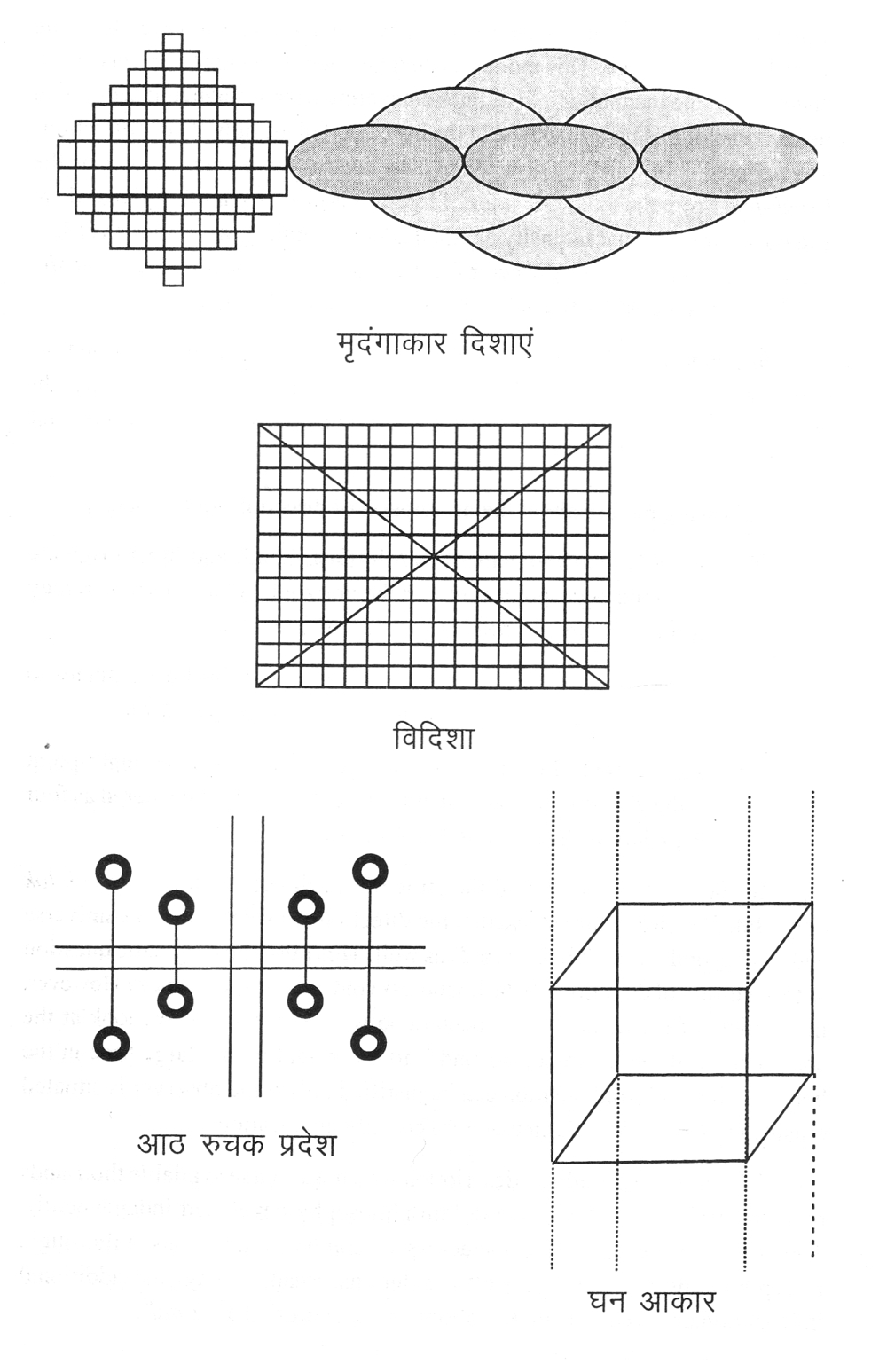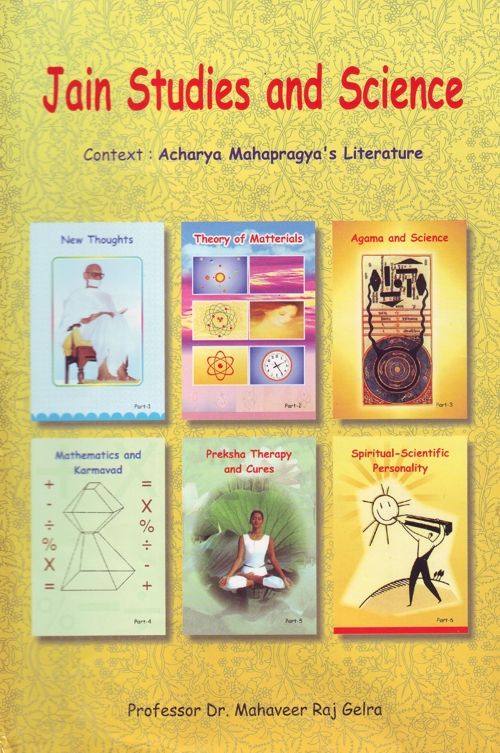In the previous chapter, we dealt with the first two mattereals namely, Dharmastikaya (dynaons) & Adharmastikaya (statons). Currently we shall ponder upon the third entity- SPACE. We all are familiar with the four directions East, West, North and South. They are based on the position of Sun with respect to the earth and are thus called Thermal Directions and we perceive them as straight line directions. Similarly, with reference to North Pole, any point on the earth can be described with a longitude and latitude. Interestingly, both these directions are curved. But most of the times we neglect one very important aspect of directions - definition of zero (reference) co-ordinates. Sense of direction, therefore, emerges from the very basic presumption of zero location. Delhi is to our east if we are at London and to our west if we are at Tokyo. So, in broader perspective of Universe, Jain Aagams enumerate seven ways to describe directions with reference to the centre of the Lok called 'ruchak pradesha'. Ruchak pradesha, an eight point centre, is defined as the zero reference co-ordinates in the Jain description of directions. The Acharang Ninukti further describes seven epithets of each direction - Name (Naam), Positioning (Sthapand), Contents (Dravya), Area (Kshetra), Thermal Properties (Taap), Intelligence (Pragyapak), and Quality (Bhava).
1.Ancient BeliefsAn in-depth description is found in various ancient contemporary doctrines regarding space and directions. Two main non-Jain concepts are -
- Space and directions are two separate and independent entities.
- Nyay & Vaishashik literature attribute sound as one the qualities of space and use directions only to define the positioning of the objects.
Jain philosophy rules out both concepts. Distinguishing space from directions, Mahapragya has written that -
"Space is an independent real entity whereas; directions are imaginary appendices of the space. Space is infinitely spread encompassing lok-alok. It neither has a beginning nor an end. It is formless and omnipresent. The positioning of an object in the space needs directions. These directions are Mahadisha, Vidisha, Anudisha, Anyadisha, Urdhvadisha, Aadhodisha and Tiryakdisha."
Discarding the second opinion Mahapragya comments that sound needs matter to originate and propagate, whereas the space is formless and boundless. Therefore, sound, an octon, can never be an attribute or quality of the space which is formless. Space, which itself is considered afloat, accommodates all the six mattereals in it.
2.Scientific HistoryThe view point of western philosophers with regard to the attributes of space had always been divergent from the Jain philosophy. Plato believed that there was nothing like independent or floating space, but it is associated with the physical objects only.
Einstein's general theory of relativity attached time with the space as a fourth dimension. This had made the entire studies of space and directions all the more interesting and challenging. We shall therefore, endeavour to explain the contents of Jain scripture in the light of modern scientific discoveries.
3.Curved DirectionsIn Bhagwati Sutra, the directions are said to be curved having a shape resembling a mrudang (an oval shaped or egg-shaped musical instrument). It states that the co-ordinates of space may follow straight lines, but directions are curved as their trajectory is a sum total of seven attributes including the area, quality and contents etc. Scientists today have almost concluded that the excessive gravity results in the curved space-time to accommodate very high density matter in a very small volume of space. Some such examples are -
- Black-holes manifest extremely high gravitation due to their high matter density. So much so that even the light cannot escape from them.
- All the stars have a strong gravitational pull that the light rays passing near them get curved.
- At the moment of big-bang, space-time was curved to such an extent that infinite mass was contained in literally miniscule volume.
According to the physicist Hawking, when we try to visualise four-dimensional object in three-dimensions, or three-dimensional in two, or two-dimensional in one dimension, objects appear to be curved. This has made scientists enthusiastic to find a possibility to device a method in which the hidden curved dimension is revealed which will shrink our distances from stars and journey towards them will then be possible. In the universe of flat space-time, the nearest star is around 4.2 light-years away. Until this distance is curved up, any possibility to receive information from them is quite remote. Scientists are also working on another possibility of 'warm-holes'. These warm holes are the ones which add another dimension to any spatial arrangement. For instance, if a hole exits between North and South poles, we need not travel the earth's curvature; instead, we travel diagonally, a substantially low distance. It is all about finding such hidden directions which are curved up in the space-time universe.
In this context, the description of directions available in Jain literature is full of immense possibilities and scholars can base their research on this subject. According to Jain philosophy, a 'unit' space can accommodate infinite 'anant pradeshi pudgals (vyavaharic parmanu)'. This can be understood only with the help of curled up directions which are capable of containing unlimited mass.
4. Agamic Description of DirectionsIn Acharang Sutra, a very interesting episode of re-birth enumerates various directions -
I have come from Purvadisha (East)OR from Dakshindisha (South)
OR from Pashchimdisha (West)
OR from Uttardisha (North)
OR from Urdhvadisha (upwards)
OR from Aadhodisha (downwards)
OR from Anyadisha (Other direction)
OR from Anudisha (Perpendicular direction)
Eight directions find mention in this event. While the six directions are well known, significance of other two needs investigation. Before this is dealt with any further, the details excavated by Mahapragya from the ancient Agamas are worth mentioning. All directions including the vertical perpendicular direction originate in the Triyak-lok. These directions initialise from the central ruchak-pradesh comprised of eight-points arranged in the form of a cube. According to the data available, author has a geometrical basis to presume this cube as all its sides equal to 800 yojans. From every corner of this cube, there is incremental pattern in the multiples of two. This blueprint extends in the entire horizontal plane. This model, as depicted below, seems to be very much analogous to the magnetic field of lines emanating from a magnet. It seems that the contours of this pattern extend in the horizontal plane only. These directions are restricted in upward and downward directions as these areas lie outside the Triyak-lok. From the magnetic lines of forces it is clearly manifested that if we join the points of equal intensity or equal Bhaav (quality), we obtain a vertical line parallel to the side of the central cube. This, logically, must be Anudisha which follows the path of equal strength in the vertical plane.
In Acharang-Niryukti, directions are discussed in greater details and we find mention of four Vidishas, which are not curved but are assigned a straight line shape. These four Vidishas are like line segments without the incremental growth pattern.
Following picture about the description of directions thus emerges -
- Four Mahadisha, namely North, East, South and West originate from the eight-point centre in the horizontal plane. Together, they represent two co-ordinates in the horizontal plane.
- Anudisha, the vertical dimension, adds the third co-ordinate to complete the three-dimensional picture of the Triyak-lok.
- As the central area is not a singular point, but is an eight-point cube, the four diagonals inside this cube may be considered as four Vidishas as described in the Agamas.
So far we have discussed the structure of directions in the Triyak-lok only. But, Bhagwati sutra states that the directions travel through the universe and run beyond it into the alok(void) as well. This raises an enigmatic question as to the utility of directions in the boundless void outside the cosmos? However, in the view of the author, it has been done with a purpose. If we look at the construction of the universe, we find it to be upright with a large base in the bottom. This preferred position can be justified only if the observer is situated outside the lok at some particular zero co-ordinate location.
This highly specialised description which was made available thousands of years back establishes that the Jain philosophy developed independently. Though a vivid reader may come across several trivial questions, a thorough, in-depth study is essential for clear solutions. Readers may find additional information on directions in the following chapter titled as 'Kaal'.

 Dr. Mahavir Raj Gelra
Dr. Mahavir Raj Gelra

